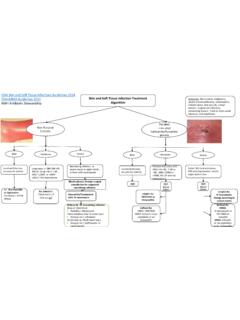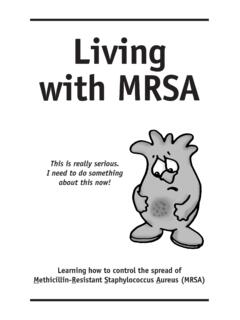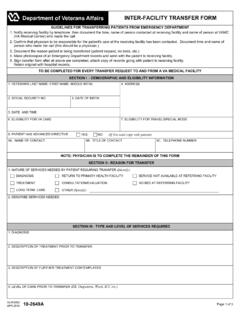Transcription of MRSA Skin infection SignS And SyMptoMS
1 For more information, please call 1-800-CDC-INFO or visit how to recognize and prevent MRSA skin infections . MRSA Skin infection SignS And SyMptoMS :MRSA and other staph skin infections often appear as a bump or infected area on the skin that may be:> Red> Swollen or painful> Warm to the touch> Full of pus or other drainageIt is especially important to contact your healthcare professional when MRSA skin infection SignS and SyMptoMS are accompanied by a fever. Bernard Cohen, MD, Dermatlas; Bernard Cohen, MD, Dermatlas; child S fiRSt line of defenSe AgAin St MRSA:A well-infoRMed is MRSA?MRSA is methicillin - resistant staphylococcus aureus , a potentially dangerous type of staph bacteria that is resistant to certain antibiotics and may cause skin and other infections .
2 MRSA is spread by having direct contact with another person s infection , by touching surfaces or items contaminated with MRSA, or by sharing personal items such as towels or razors that have touched infected are the SignS and SyMptoMS of MRSA skin infections ?MRSA skin infections can occur anywhere on the body. Some common sites are the legs, buttocks, groin, and back of the neck. MRSA usually appear as a bump or infected area that is red, swollen, painful, warm to the touch, or full of pus. If you or someone in your family experiences these SignS and SyMptoMS , cover the area with a bandage and contact your healthcare professional.
3 It is especially important to contact your healthcare professional if the SignS and SyMptoMS are accompanied by a fever. How are MRSA skin infections treated?Treatment for MRSA skin infections may include having a healthcare professional drain the infection and, in some cases, prescribe an antibiotic. Do not attempt to drain the infection yourself doing so could worsen or spread it to others. If you are given an antibiotic, be sure to take all of the doses (even if the infection is getting better), unless your healthcare professional tells you to stop taking it. Do not share antibiotics with other people or save them to use I have an MRSA skin infection , how do I prevent others from getting infected?
4 Cover your infection . Pus from an infected area can contain regular staph or MRSA, so keeping it covered will help prevent spreading the infection to others. Follow your healthcare professional s instructions about proper care of the infection . Be sure to discard bandages in the your hands. You and your family should clean your hands frequently with soap and water or an alcohol-based hand rub, especially after changing the bandage or touching the infected not share personal items. Avoid sharing personal items such as towels, washcloths, razors, or clothing that may have had contact with the infected area or bandage.
5 Wash soiled sheets, towels, and clothes with water and laundry detergent. Use a clothes dryer to dry clothes completely. How can I protect my family from MRSA skin infections ? > Know the SignS of MRSA skin infections and get treated early > Keep cuts and scrapes clean and covered > Encourage good hygiene such as cleaning hands regularly > Discourage sharing of personal items such as towels or razorsFor more information, please call 1-800-CDC-INFO or visit youR fAMily fRoM MRSA Skin infectionSDeveloped with support from the CDC Foundation through an educational grant from Pfizer Inc.














